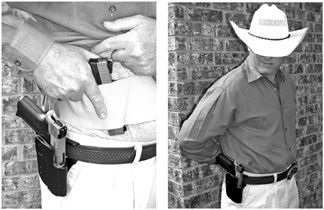
One of the oldest and most concealable ways to carry a handgun is to use a bellyband, a close-fitting elastic band that hugs the body and includes one or more holster pockets. This type of concealment could be called “deep carry,” since the pistol is located in a place where it’s not expected. But to work as a deep-carry gun in a bellyband, the gun needs to be flat and light weight.
We recently tested three pistols we believe are suitable for this type of concealed carry: the Kahr TP9, $676; Kel-Tec’s P11, $368; and the Smith & Wesson 908S, $603. In this specialized test, we compared the guns on reliability and other factors in our normal tests, but we particularly examined their lack of edges, assessed their speed of deployment from deep cover, and looked at their operation when only one hand was available. Here’s what we found:
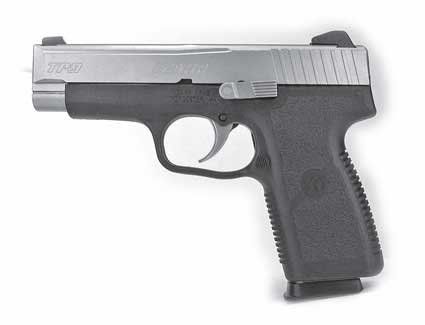
Kahr Arms, located about 30 miles north of New York City, makes guns only in 9mm Parabellum and .40 Smith & Wesson, and all 24 of the company’s models are double action only (DAO) feeding from a single-column magazine. The TP9 and other Kahrs are slim, lightweight pistols with more capacity than a revolver. Kahr describes the operation of its pistols as being locked breech with a “Browning-type” recoil lug.
On the gun we noticed no external safeties, but it used a passive striker block. The TP9 will fire without a magazine in place. The TP9 can be stored with the trigger padlocked with a provided polymer block that fits tightly inside the trigger guard. All Kahr pistols are topped with a stainless steel slide, but choices of frame material include polymer as well as stainless steel. The heaviest pistols in the Kahr lineup weigh upwards of 27 ounces. We chose the TP9 (catalog number TP9093A) because its polymer frame limited weight to about 18 ounces.
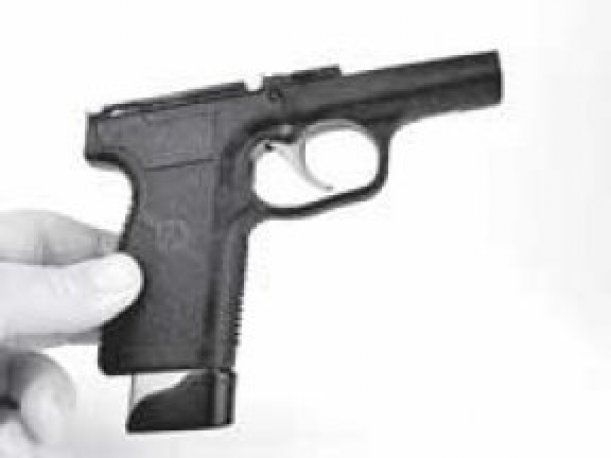
Another reason for our choice was that this model came with an adjustable rear sight from MMC that we were eager to evaluate. This was a three-dot sight with a well defined rear notch nestled in a protective frame. This pistol was also available with Novak tritium sights for an additional $138.
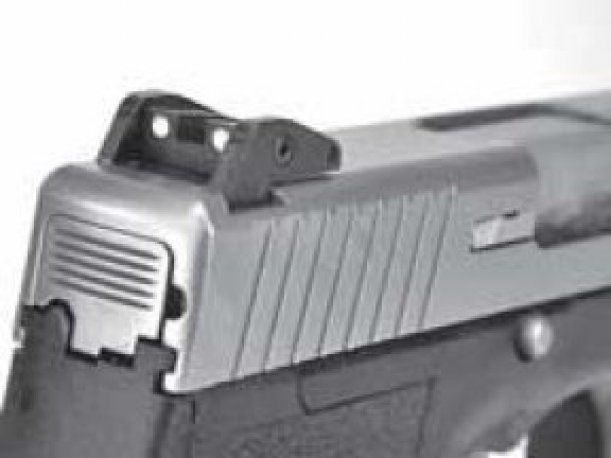
Our pistol arrived with two magazines. The seven-round magazine added 0.3 inch to the overall length of the grip, and this included a pinky rest. The eight-round magazine added 0.8 inch in overall length. Our TP9 offered a decidedly muzzle heavy feel not unwelcome in a lightweight pistol. The source of this weighty feel was, of course, the matte stainless-steel slide with externally mounted extractor and the 4-inch stainless-steel ramped barrel.
Removing the top end for cleaning or inspection began with releasing the magazine and clearing the chamber. The owner’s manual asked us to move the slide about 0.75 inch to the rear to align the slide-stop pin with the relief in the slide. Then, we used a “non-marring” hammer or the plastic grip of a screwdriver to tap out the pin. We found this to be no easy chore. The fact was that the slide needed to be moved more than 1.25 inches rearward to remove the stop pin. Actually, the squared relief in the slide needed to be centered above the rear portion of the slide stop to release the locking lug and not just the slide stop pin itself. We also spotted a small vertical line cut into the slide. Coincidentally, we found that lining up this cut with the letter “S” of the engraving in the frame that read Kahr Arms was a good way to index the frame and slide for field stripping. With the pin removed, the trigger needed to be pressed to release the slide forward and off the frame.
With the slide removed, we saw that slide-to-frame contact was almost entirely steel to polymer, save for two small 0.2-inch-long steel inserts on either side at the rear of the frame. With the top end removed, the lower assembly of the Kahr TP9 weighed a feathery 3.7 ounces.
In the hand, the grip of the Kahr TP9 felt narrower than its 1.1-inch width. The polymer frame was pebble finished on the sides, with a more aggressive pattern molded into the front and back strap surfaces. Due to the narrow grip and distinctive rectangular feel, it was easy to get a solid grip on this pistol. Indexing the gun felt natural and decisive.
We shot from a sandbag rest at 15 yards. The Kahr TP9 finished second to the Smith & Wesson 908 in accuracy, but it still performed admirably. We were able to land five-shot groups measuring slightly more than 2.0 inches firing both the 115-grain JHP/XTPs from Hornady and the 124-grain Speer Gold Dot Hollowpoints.
One of the tests we use to assess the real-world shootability of a handgun is to engage a paper target fixed 7 yards downrange. We stand unsupported and present the gun from the low ready position (muzzle pointed downrange lowered to approximately a 45-degree angle). Our choice of target was the ABC16 Training Target from Hoffners, (713) 957-1200. This 23- by 34-inch target offers six 3-inch circles in its borders but in the center was a silhouette. Chest, or center mass, was the A zone and a head shot was marked with the letter B.
Our procedure was to shoot nine separate strings of fire, each one consisting of two shots to the A zone and one shot to B zone. We used the inexpensive Winchester USA 115-grain FMJ rounds in this phase of the test.
Our instinct said that a TDA gun (first shot double action, subsequent shots single action) such as the Smith & Wesson 908S would have an advantage. But the Kahr TP9 double-action pistol had a wide trigger face and a consistent trigger break point of 8 pounds that showed promise, too. Also, the hinged trigger had a short, quick feel. Trigger span measured from the center of the trigger to the nearest edge of the back strap was 2.4 inches. Taking up slack in the trigger accounted for 0.1 inch of movement, with the trigger breaking after it was pressed rearward another 0.1 inch. Overtravel, or the distance the trigger moved rearward after the shot until it stopped was 0.05 inch in length.
The results of our rapid-fire test showed acceptable accuracy and control, we thought. Of 18 potential shots double-tapped when aiming at the A zone, we landed 10 shots in the A zone, put seven shots just outside this 5.5- by 8-inch rectangle, and pushed one shot off to the left about 1 inch.
Also, like other DAO pistols, the TP9 was tiring to shoot.
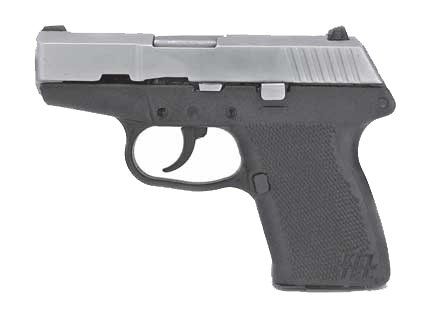
Kel-Tec CNC Industries started out as a machine shop in 1991 and began manufacturing firearms some four years later. Small-caliber pistols with polymer frames, locked breech actions, and DAO triggers continue to be Kel-Tec’s bread and butter. The P11 is a 9mm handgun with a 3.1-inch barrel. Capacity was 10+1, thanks to a double-column magazine. The suggested retail price of the base model was only $314 and featured a blued slide. Our P11 carried a hard-chromed slide and cost $368, but the same gun was available for $355 should you choose a P11 with a Parkerized finish.
The inexpensive Kel-Tec P11 shared at least one design concept found on some more expensive pistols. The P11 slide did not ride primarily on polymer rails. An aluminum frame was set into the polymer receiver, which also housed the firing mechanism. Removing the top end to get a better look inside began with removing the magazine, emptying the chamber and locking back the slide. The assembly pin, which was on the left side directly above the trigger, was now in position to be removed. It was designed to be plucked out of the frame with the use of a case rim. (Almost any caliber will do.) The guide rod was polymer, and the recoil system used two coil springs one over the other. Replacing the slide meant fitting it to the aluminum rails, locking it back, and pushing the barrel all the way forward to expose the cut in the barrel to the assembly pin hole. Once the pin was inserted, the slide was unlocked and moved forward to its rest position.
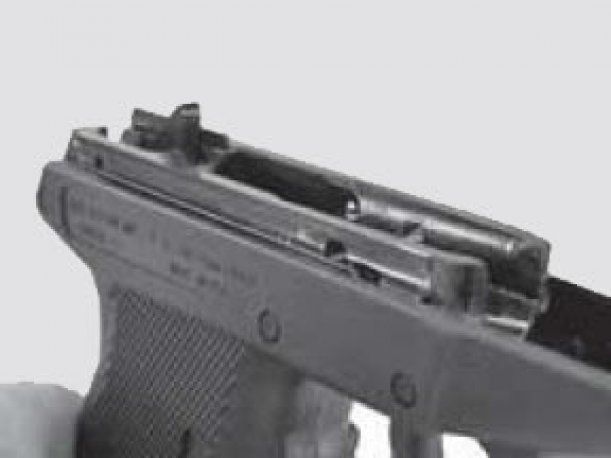
The Kel-Tec P11 came in a very small cardboard box with an owner’s manual and a padlock. The only magazine supplied was a 10-round model, but according to the website some P11s were shipped with nine-round magazines. The grip on this pistol is short, so most shooters will find it difficult to grasp the P11 with more than the middle and ring fingers across the front strap. Still, we had no difficulty stabilizing the P11 on the shooting bench, and there were no malfunctions.
We found performance with the 124-grain Speer Gold Dot hollowpoints to be more than satisfactory. Our five-shot groups ranged from 1.6 to 2.4 inches measured center to center. Accuracy with the other test rounds was disappointing. In each case average group size was 3.9 inches.
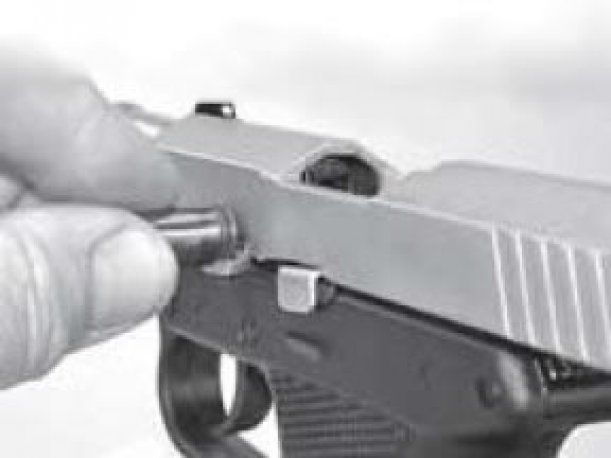
In our practical test at 7 yards, the results showed two strong characteristics. Thirteen of the 18 total shots were off center to the left. The central A zone had only three hits to the right of center, with the majority of bullet holes grouped 2 to 3 inches to the left of point of aim. One shot dropped all the way down to the C zone, representing the groin area of the humanoid silhouette. All but two of our head shots were left of center, and they were also much lower than intended.
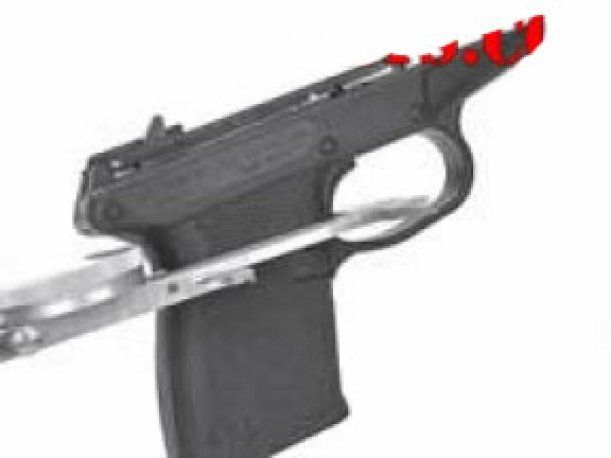
In truth, this was a shooting problem we attributed to the operator. But why did it happen? First let’s analyze the movement of the trigger as we did before. Trigger span at rest from the center of the trigger face to the nearest edge of the back strap measured 2.9 inches. There was 0.1 inch of take-up before the trigger finger met resistance. Ignition was at a span of 2.2 inches. Upon release, the firing mechanism did not reset until the trigger had returned nearly all the way back to the initial point of resistance. This meant that the shooter had to withstand a measured 10 pounds of pressure throughout a movement covering approximately 0.6 inch, all the while steering the front sight to proper alignment. Obviously, fatigue became a factor.
In fact, the Kel-Tec required us to dedicate a separate day for testing. This was because our fingers were too worn out after any length of range session with the P11 to effectively continue with a second or third pistol. Thus, one of the underlying problems presented by the P11 is that a gun this uncomfortable to shoot will soon discourage regular practice sessions.
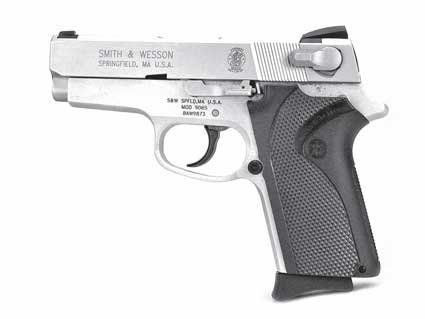
The 908S Carry Combo had an alloy frame instead of polymer (like the other guns used), and this pistol operated with a traditional double action (TDA) trigger with a combination decocker/safety lever on the left side of the slide. The lever can be changed to the right side for left-handed shooters.
The 908S Carry Combo differed from a standard 908S only by the inclusion of an Uncle Mike’s Kydex belt-slide holster. This holster was smartly shaped with the contours of the pistol and was a stylish addition, even if it did not provide the deepest concealment. According to the manufacturer’s website (www.smith-wesson.com), the 908S with its stainless-steel slide and its brother the 908 with carbon steel slide each weighed 24 ounces. Ours weighed 22 ounces without a magazine, 24 ounces with. The polymer grip panels that wrapped around the back strap of the 908S provided a comfortable grip but did not add unnecessary width. We liked this because the narrow profile helped to provide a natural index in the hand. The frontstrap was smooth, and most shooters will be able to fit at least two fingers beneath the trigger guard with the pinky resting on the lip of the base pad extension supplied on the magazine. The magazine release was slightly extended and easy to find. The decocker was readily available to the thumb, making one-handed operation an easy chore. We used a downward stroke to decock to the safety-on position. Safety-off, ready to fire, a first shot double action required a separate upward stroke of the lever. Return to single action fire required manually moving back the slide with the danger of ejecting a live round. Thumbing a spurred hammer would solve this problem, and replacing the flush-fitting hammer with a spurred model is an aftersale option available from Smith & Wesson. This gun would not fire without a magazine in place.

0)]
The sights were a three-dot Novak design, and we liked the fact that both the front and rear units were dovetailed into place. The slide featured rear cocking serrations and an externally mounted extractor.
We measured the weight of the single- and double-action trigger pulls at 7 and 12 pounds respectively. The trigger span at rest in double action was 2.9 inches, and the span at rest single action was 2.5 inches. In single-action mode the trigger moved 0.1 inch before encountering pressure. The break happened 0.05 inch later. Overtravel accounted for another 0.05 inch of movement. The firing mechanism reset at the 2.4-inch mark and stopped its forward movement at a span of 2.5 inches.

1)]
The double-action trigger had a much shorter take up, approximately 0.025 inch, but its break point required rearward travel of 0.5 inch (at a trigger span of 2.4 inches). Overtravel was 0.05 inch. From its most rearward position (a trigger span of 2.35 inches), the trigger then reset at the 2.4-inch mark ready for single-action fire.
We found operating the 12-pound double-action trigger on the Smith & Wesson to be less tiring than the 10-pound DAO trigger on the Kel-Tec because our hand was able to work from a more desirable grip, and the DAO press only occurred once per string of fire, not on every single shot. In comparison, however, the Kahr’s 8-pound trigger seemed almost refined.

2)]
We began our 7-yard practical test of the Smith & Wesson with a double-action first shot to the center mass A zone. We quickly followed up with a single-action second shot to this same point, and then transitioned to the head, or B zone, firing one shot single action. Out of 18 A-zone shots, we placed only one shot wide left of the A zone, and we dropped one shot out of nine well below the B zone. Overall, however, we registered our best results with the 908S, with a count of 25 out of 27 rounds landing inside the intended target areas.
From the sandbag rest, we recorded groups single-action only. With smallest and largest groups measuring from 1.4 to 2.4 inches for all shots fired and an overall average of 1.9 inches, the 908S handled 15-yard shots with ease. We did try decocking between shots to get a feel for its double-action capability, and we found that accuracy on a par with the Kahr TP9 was possible with little or no practice.
Gun Tests Recommends
• Kahr TP9 9mm, $676. Buy It. With the addition of the MMC rear sight and an improved trigger over previous models, we think this gun is a desirable concealed handgun. For anyone willing to dedicate themselves to DAO fire, the TP9 is a good bet.
• Kel-Tec P11 9mm, $368. Conditional Buy. The high capacity of this little gun is a plus, but we would not be comfortable with this pistol for anything but close-range fire.
• Smith & Wesson 908S, $603. Our Pick. The 908S offered smooth transitional fire for close quarters work and greater long-range accuracy than the other two pistols. We think it did the best job of bridging the gap between a hideout gun and a primary gun.






























